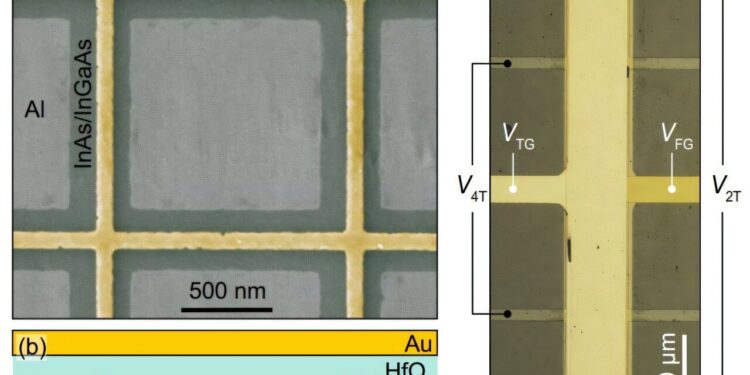(a) Colorized scanning electron micrograph of a reference device, taken before deposition of the overall top gate. The square Al islands (gray) are arranged on top of the semiconductor heterostructure (green-gray) and are separated by a frame grid (yellow). (b) Schematic cross-section of the device illustrating the double-gate geometry. The lower frame gate adjusts the central part of the junctions, while the overall upper gate adjusts the 2DEG surrounding the islands. (c) Optical micrograph of the measured Hall bar device showing the measurement setup. Credit: Physical Examination Letters (2025). DOI: 10.1103/xbm4-37cf
Researchers at the Niels Bohr Institute at the University of Copenhagen have taken very thin conductors from superconductivity to insulation, creating a strange “impossible” state between the two mutually exclusive states.
Materials research is absolutely crucial when dealing with quantum states. Regardless of the material used as a basis for creating controllable quantum states, for example if you want to create applications using quantum states for computing, sensing or communication, the materials often define the extent to which you can eliminate the omnipresent noise that disrupts or even disrupts the desired “clean” quantum states or signals. It’s an ongoing battle.
The team led by Saulius Vaitiekenas, associate professor at the Niels Bohr Institute, managed to create what is believed to be an impossible intermediate state between superconductor = absolutely no resistance or loss of electrical connection – and total isolation = complete cutoff of the electrical signal.
The work is published in the journal Physical Examination Letters.
The crosstalk standard made this unexpected behavior possible
The group built an “array” made up of tiny superconducting islands equipped with a voltage knob – much like a transistor – that allowed them to control the crosstalk between these islands. According to an old prediction, the system was to move from the superconducting stage, when the islands are allowed to “talk” to each other, to the directly insulating stage, when they are disconnected.
Instead, the researchers discovered an intermediate state in which the islands continue to communicate with each other, but without superconductivity. Because of this unexpected behavior, the condition is called anomalous metallic regime.
“Our study sheds more light on this state, indicating that it is the quantum fluctuations, or, to be a little more precise, the uncertainty between the superconducting phase between the islands and the number of particles in the islands in our sample, that are causing this behavior,” says Vaitiekenas.
Quantum phase transitions – and their understanding – are one piece of a big puzzle
The experiment sheds light on the long-standing question about anomalous metal – an unexpected state of matter that was observed when devices transitioned from superconductor (perfect conductor) to insulator status.
As Vaitiekenas explains, “Understanding such quantum phase transitions is like solving a big puzzle. One piece at a time may not reveal the whole picture, but, in the long term, it could be a step forward toward electronics that waste less energy and more controllable and reliable quantum devices for future applications.”
Contributors to this work are Satyaki Sasmal, Maria Efthymiou-Tsironi, Gunjan Nagda, Emma Fugl, Lara Liva Olsen, Filip Krizek, Charles M. Marcus and S. Vaitiekėnas.
More information:
S. Sasmal et al, Voltage-tuned anomalous metal-to-metal transition in Josephson junction hybrid networks, Physical Examination Letters (2025). DOI: 10.1103/xbm4-37cf. On arXiv: DOI: 10.48550/arxiv.2505.12536
Provided by the University of Copenhagen
Quote: An abnormal metal highlights an “impossible” state between superconductivity and insulation (2025, October 14) retrieved October 15, 2025 from
This document is subject to copyright. Except for fair use for private study or research purposes, no part may be reproduced without written permission. The content is provided for informational purposes only.



